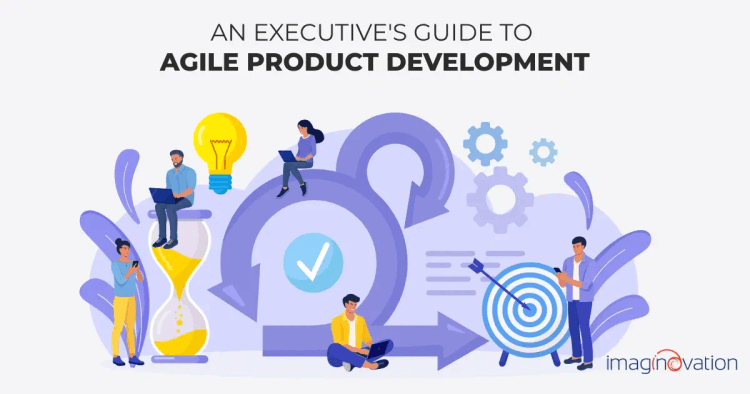In an era of fast-paced innovation and disruption, traditional product development methods have become obsolete.
Agile Product Development is a flexible and collaborative approach that has gained immense popularity in recent years.
Agile is not just a buzzword; it's a mindset, a methodology, a game-changer.
But what exactly is Agile, and how can you make it work for you?
In this blog post, we'll talk about the fascinating realm of Agile Product Development and understand its fundamental principles. We will also explore the challenges you might face when implementing it.
So, get ready to embrace agility and revolutionize the way you approach product development.
Understanding Agile Product Development
Agile product development refers to practices and methodologies based on the principles and values laid out in the Agile Manifesto.
With the Agile framework, development teams create products through brief, iterative cycles based on continuous customer feedback and swift improvements.
In short, Agile product development is a transformative methodology that revolutionizes how products are created and delivered.
In a business landscape where innovation is the key to success, Agile empowers you to embrace change, respond swiftly to customer needs, and stay one step ahead of the competition.
So, instead of following a linear, pre-defined plan, Agile encourages cross-functional teams to collaborate, experiment, and iterate in short, time-boxed cycles called sprints.
Moreover, with its emphasis on transparency, feedback, and continuous improvement, Agile ensures that projects stay on track and stakeholders remain engaged throughout the development process.
Agile product development provides organizations with the flexibility and agility to navigate fast-changing markets, drive innovation, and achieve tangible business outcomes.
Agile product development presents distinct advantages compared to traditional product development approaches.
Here are the key benefits of Agile product development.
1. More Flexibility
At the core of Agile is flexibility. Agile teams are highly responsive to change and easily adapt without significant disruption. Unlike rigid plans in conventional product development, project deliverables in Agile are not fixed. This allows teams to adapt to changing requirements.
2. Speed
The speed of Agile product development comes from the iterative approach, adaptability to changes, and collaborative teamwork. All this enables faster delivery of products and quicker response to market dynamics.
3. Reduced Risk
Agile product design lowers the risk of misaligned products. Early testing with customers allows for rapid adjustments in the next sprint, minimizing monetary risks and maximizing results.
4. Better Quality
Agile methodologies employ iteration in project management, where each cycle brings process enhancements. This commitment to improvement and quality control stands as a key Agile principle, fostering the creation of superior products.
5. Transparency
Agile product development provides visibility into the progress of the project. This enables all stakeholders to stay informed, monitor, provide feedback, and make timely decisions. Transparent workflows offer control and monitoring in product development.
6. Customer Satisfaction
Agile teams engage customers in the product development process. This keeps them informed and lets them know that their input/feedback is valued. Prioritizing customer needs leads to products aligned with their needs.
7. Enhanced Collaboration
Agile product development enables continuous improvement through regular reflection and adaptation, implementing feedback-driven iteration cycles. It also fosters a collaborative learning culture within the team, promoting collective knowledge and best practices.
Also Read: Product Development Strategy 101: Defining Your Product Vision and Roadmap
Key Principles of Agile Product Development
The principles of Agile product development are based on the Agile Manifesto, which outlines a set of 12 guiding principles.
The Agile Manifesto came up in response to the need for greater organizational flexibility and adaptability. It was created by a group of software developers who sought to address the limitations of traditional, plan-driven approaches in software development.
By following fundamental principles, Agile teams can effectively navigate the complexities of product development, adapt to changes, and deliver exceptional products that meet customer requirements.
Let’s explore these principles and their roles in achieving successful project outcomes.

1. Customer satisfaction through early and continuous delivery
This Agile principle places customer satisfaction at the forefront. Early and continuous product delivery is pivotal in meeting customer demands and generating faster returns on investment (ROI).
By implementing this principle, you'll elevate the agility of your processes, enabling you to respond promptly to changing requirements and market dynamics. Concurrently, your customers will be happy with your services and product, as they'll receive value at more frequent intervals.
2. Embracing changes in requirements even in later stages of development
The second Agile principle talks about the significance of accommodating change requests, even during the later stages of project execution. To quote the original text of this principle, Agile teams should "welcome changing requirements, even late in development."
In traditional project management, late-stage changes often ring alarm bells, as they can lead to scope creep and increased costs. However, Agile teams operate with a different perspective. They thrive on uncertainty and recognize that even a late change can bring significant value to the customer.
Thanks to the iterative nature of Agile, teams are well-equipped to respond promptly to these changes. This approach allows for incorporating valuable insights and adjustments without derailing the project's progress.
3. Frequent delivery
The essence of this principle lies in the wisdom of smaller and more frequent releases. This approach substantially reduces the risk of errors creeping into the final product. By frequently delivering new increments, you offer consumers numerous opportunities to provide feedback.
This feedback loop is vital for developers, enabling them to rectify potential issues that might otherwise jeopardize the project's success.
Now, imagine a scenario where developers only receive feedback every few months. In such cases, any errors that emerged early in development could have evolved into complex challenges, demanding more time and resources to resolve.
4. Collaborate to break the silos
In traditional management practices, a clear division typically exists between the roles of business owners, stakeholders, and developers.
However, Agile introduces a significant shift here. It emphasizes the necessity for stakeholders, customers, and developers to collaborate closely. This collaborative approach is designed to achieve project goals more effectively. It does so by reducing the risks in project development.
In addition, the increased management involvement deepens understanding of developer challenges, fostering transparency and enhancing Agile project success.
5. Autonomy and motivation
It's crucial to recognize that constant micro-management rarely serves the best interests of project development.
Effective project development hinges on trust in your development teams. Proper Agile training and resources grant developers autonomy to determine the best approach to complete their assignments.
Remember, motivated professionals take pride in their work. Building projects around such individuals is key to success. Management's role is to cultivate an environment that rewards achievement, encourages collaboration, and supports work-life balance.
Provide the tools and motivation, and you'll reap smoother project development and improved ROI.
6. Better communication with face-to-face interaction

Technology offers businesses numerous communication avenues, yet only some can truly replace the effectiveness of face-to-face interactions.
2020 marked a significant shift in our work landscape, with an unprecedented number of employees working remotely. Consequently, businesses increasingly rely on communication platforms like Skype and Microsoft Teams.
However, it's worth noting that while these tools serve a purpose, the potential for communication errors escalates in the absence of face-to-face contact. Vital information can become muddled in translation, and important emails and memos may be buried in overflowing inboxes, impacting effective communication within teams.
7. Working software - Primary measure of progress
The 7th Agile core principle is unequivocal.
Regardless of the hours invested, the bugs resolved, or the lines of code written, the ultimate measure of success is meeting customer expectations.
Deviation from these expectations can pose significant challenges and setbacks.
8. Sustainable working pace
Maintaining a demanding release schedule can strain a team, particularly if expectations are unrealistic.
The eighth Agile principle advocates for setting clear, attainable expectations.
This approach aims to preserve team morale, enhance work-life balance, and mitigate burnout within cross-functional teams.
9. Continuous Excellence Enhances Agility
While Agile promotes shorter cycles and frequent releases, it also significantly emphasizes maintaining a clean and organized codebase to prevent future issues. Product managers may sometimes overlook this aspect as they don't typically delve into codebases, yet it remains crucial to them.
While implementing this principle, the team must remain aware of technical debt and its implications when introducing new features or initiatives to the backlog. Developers and product managers should collaborate to assess when technical debt is permissible.
Periodically, product managers must allocate development resources for refactoring efforts. Refactoring cannot be an afterthought; it requires ongoing attention and consideration.
10. Simplicity is essential
To implement this principle effectively:
- Streamline processes by eliminating unnecessary steps that don't enhance project quality or progress.
- Automate repetitive or time-consuming tasks to increase efficiency.
- Utilize pre-existing assets from prior projects rather than starting from scratch each time.
Moreover, sustaining this principle demands ongoing effort. Agile teams should always seek improvement, embracing technological advancements and adapting to modern trends.
Maintaining agility involves frequent meetings, many of which should focus on discovering and implementing better ways to accomplish tasks, making continuous improvement a core practice.
11. Self-organizing teams

Traditional software development often features hierarchical teams, with management holding decision-making authority over contributors.
In contrast, Agile principles advocate for self-organizing teams with a “flatter” management approach, where decisions are collectively made rather than being the sole responsibility of a single manager or management team.
This concept aligns with Agile's emphasis on valuing teams and interactions over processes and tools, aiming to empower teams to collaborate effectively and make decisions as a cohesive unit.
12. Regular reflection and adjustment
This last principle is a litmus test for successfully integrating Agile methodologies into business strategy. Agile's effectiveness hinges on reflecting on past successes and failures and adapting approaches accordingly.
Doing so needs effective communication, feedback mechanisms, a grasp of Agile methods, and an environment fostering innovation and learning from errors.
While no team is flawless, a mature, informed, and responsible team can enhance itself through proactive and reactive measures, continually improving the development process.
Also Read: 10 Digital Product Development Pitfalls and How to Avoid Them
Implementing Agile Product Development
Implementing Agile product development involves several key steps. Here's how you can transition to an agile process.
1. Educate and train
Start by educating the team and stakeholders about the Agile mindset, principles, and methodologies. Provide training to ensure everyone embraces the Agile mindset and understands their respective roles in Agile product development.
2. Build Agile teams
Create self-organizing and cross-functional teams comprising members with the necessary skills to deliver the product. Empower the team to make decisions and take ownership of their work.
3. Build a product backlog
Collaborate with the development team to define product features and requirements, creating a prioritized product backlog. This backlog outlines the essential features needed for the desired product.
4. Continuous Communication & Collaboration
Foster open lines of communication and collaboration amongst team members, stakeholders, and customers. Regularly engage in feedback and review sessions to ensure continuous improvement and alignment.
5. Iterative product building
Break down the product development into small interactions or "sprints." Complete tasks in these sprints from the product backlog, incrementally building the features while ensuring frequent adaptation to customer feedback.
6. Embrace Change
Be open to change throughout the development process. Regularly evaluate and adjust priorities, requirements, and plans based on customer feedback and evolving business needs.
7. Test early and often
Integrate testing at each product development phase to receive real-time feedback, enabling continuous improvements.
8. Regular Reflection and Adaptation
Encourage the team to regularly reflect on their work, processes, and collaboration. Hold retrospectives at the end of each iteration to identify what worked well and areas for improvement.
Challenges of Agile Product Development
Agile has proven to be an effective approach in responding to customer needs and delivering value. However, like any other development methodology, Agile also faces its own set of challenges.
You can successfully navigate the Agile landscape
by understanding and overcoming these hurdles.
Let's explore the challenges you may encounter when implementing Agile product development. Let us delve into the various complexities that can arise on this journey.
1. Alignment issues within the organization and with external stakeholders
Transitioning to Agile demands alignment across all levels and functions of the organization and also with external stakeholders. While it's beneficial if Agile transformation is initiated by top management, there's a risk of forcing it on an organization ill-suited or ill-prepared for Agile.
Leaders must communicate the vision clearly to teams, highlighting benefits, strategic objectives, goals, and the enablement plan to foster team ownership and engagement.
That’s why alignment with customers, both internal and external, is vital, as Agile relies heavily on customer involvement.
Failure to align across other functions can result in operational issues, necessitating careful consideration and advance discussion.
2. Resistance to change
Changing established ways of thinking and operating within a large organization can be challenging due to old habits and beliefs. Resistance to change is common, often resulting in phrases like "that's how we've always done things" or "that never works here."
Agile methodologies require a shift in mindset and a departure from traditional practices, which can create discomfort and resistance among employees.
One common source of resistance is the preference for predictability and the status quo. Some employees may resist Agile transformations simply because they prefer stability, tradition, and familiar practices, even if they are less effective.
This resistance to changing established routines and processes can hinder the adoption of agile methods.
3. Lack of training and education

Inadequate training and education often lead to Agile transition failures.
You must grasp Agile's principles, values, practices, and frameworks to succeed. This is where the Agile Coach comes in.
An Agile Coach is an important figure, guiding the entire organization to thrive in Agile transformation. They educate the organization on Agile practices, train teams to adopt an Agile mindset and promote a culture of continuous learning.
4. Managing Scope, Cost, Schedule, Quality, and other related issues.
Product development, whether in Agile or traditional settings, commonly deals with scope, cost, timeline, and quality challenges.
In Agile projects, embracing change is a core philosophy, necessitating a robust approach to scope changes to prevent effort overruns.
These factors are interconnected and require comprehensive management. Budgeting for the entire project is another challenge addressed in Agile through risk-sharing and flexible budget, timeline, and scope planning.
Large, distributed projects pose unique challenges, but Agile has adapted to address them. Experienced Agile coaches can be instrumental in successfully managing such projects.
While Agile emphasizes product quality, process quality can sometimes be overlooked, leading to unforeseen challenges.
5. Poor communication and collaboration
Project failure often stems from communication issues.
Miscommunication is one of the common challenges faced by most Agile team members and product owners.
For Agile to function optimally, each team member should have visibility into its activities and a clear understanding of project milestones and how to achieve them. When it is not done, they cannot grasp much about the broader business context of the project and their colleagues' roles in reaching milestones.
Staying vigilant for requirement updates, showing curiosity about project goals, and adhering to well-structured documentation can make these objectives achievable.
6. Ever-changing situations
Agile projects exhibit dynamic characteristics, leading to frequent updates in requirements and a welcoming attitude toward changes.
However, this dynamism can pose challenges in achieving success in Agile product development, particularly in effectively communicating these evolving requirements to all project stakeholders.
Develop a Powerful Product with Imaginovation
In today's dynamic business landscape, embracing agility is essential for innovative product development.
At Imaginovation, we blend cutting-edge technology with a customer-centric approach to deliver transformative products.
Our Agile practices empower clients to gain a competitive edge and adapt to evolving market dynamics. With a skilled team experienced in Agile methodologies, we craft high-quality software products tailored to your business needs.
Whether you're a startup or an established enterprise, Imaginovation offers the expertise, resources, and talent to modernize your software solutions efficiently. Our Agile approach ensures efficient, speedy, and high-quality deliveries.
Contact us today. Let's discuss your requirements and explore how we can help take your business to the next level.
Ready to build an app, but not sure where to start?
We've got you covered. Click the button below to get started.





